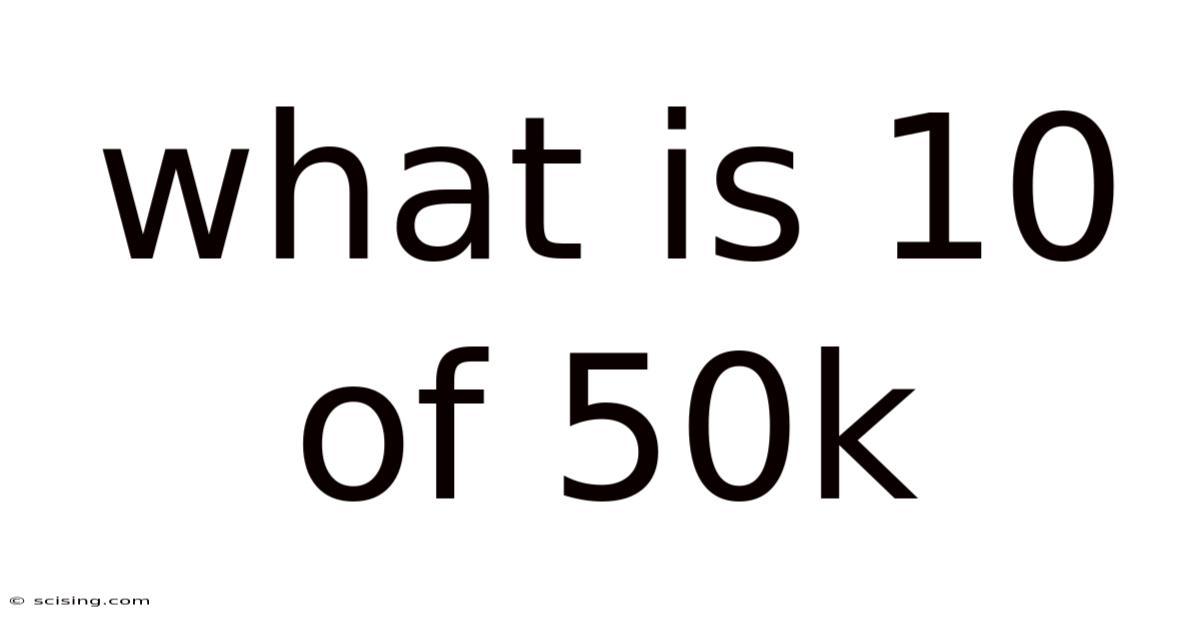What Is 10 Of 50k
scising
Sep 07, 2025 · 4 min read

Table of Contents
What is 10% of 50,000? A Comprehensive Guide to Percentages and Their Applications
Understanding percentages is a fundamental skill applicable across numerous fields, from everyday budgeting to complex financial analysis. This article delves into the calculation of 10% of 50,000, explaining the process in detail, exploring different calculation methods, and showcasing real-world applications. We'll also address common percentage-related questions and misconceptions. By the end, you'll not only know the answer but also possess a solid understanding of percentage calculations.
Understanding Percentages: A Quick Refresher
A percentage is a fraction or ratio expressed as a number out of 100. The symbol "%" represents "per cent," meaning "out of one hundred." For example, 10% means 10 out of 100, which can be written as the fraction 10/100 or the decimal 0.1. Percentages are used to express proportions, rates, and changes.
Calculating 10% of 50,000: The Simple Method
The most straightforward way to calculate 10% of 50,000 is to multiply 50,000 by 0.1 (the decimal equivalent of 10%).
- 50,000 x 0.1 = 5,000
Therefore, 10% of 50,000 is 5,000.
Calculating 10% of 50,000: The Fractional Method
Alternatively, you can use the fractional representation of 10%, which is 10/100, or simplified, 1/10.
- 50,000 x (1/10) = 50,000 / 10 = 5,000
This method demonstrates that finding 10% of a number is equivalent to dividing that number by 10. This simplification is particularly useful for mental calculations involving multiples of 10.
Calculating Percentage Using Proportions
For a more comprehensive understanding, let's explore the concept of proportions. We can set up a proportion to solve for the unknown value (x), representing 10% of 50,000:
- 10/100 = x/50,000
To solve for x, we cross-multiply:
- 10 * 50,000 = 100 * x
- 500,000 = 100x
- x = 500,000 / 100
- x = 5,000
This method reinforces the understanding of percentages as ratios and provides a systematic approach to solving more complex percentage problems.
Real-World Applications of Percentage Calculations
The ability to calculate percentages is crucial in various aspects of life:
-
Finance: Calculating interest on loans, discounts on purchases, tax amounts, profit margins, and investment returns all rely heavily on percentage calculations. Understanding 10% of 50,000 could be crucial when evaluating a potential investment opportunity or negotiating a business deal.
-
Sales and Marketing: Businesses use percentages to track sales growth, analyze market share, and determine pricing strategies. For example, a company might aim for a 10% increase in sales year-over-year.
-
Statistics: Percentages are fundamental in data analysis and interpretation. Understanding percentages allows for a clearer representation of data, such as survey results or population demographics. For instance, a survey might reveal that 10% of respondents prefer a particular product.
-
Science: In scientific experiments and research, percentages are used to express concentrations, error rates, and other quantitative measures.
-
Everyday Life: Calculating tips in restaurants, understanding discounts in shops, and determining the percentage of ingredients in recipes all require a basic understanding of percentage calculations.
Understanding Percentage Increases and Decreases
It's important to differentiate between finding a percentage of a number and calculating a percentage increase or decrease. Finding 10% of 50,000 simply identifies a portion of the original amount. A percentage increase or decrease modifies the original amount.
For example, a 10% increase on 50,000 would be:
- 50,000 + (0.1 * 50,000) = 50,000 + 5,000 = 55,000
A 10% decrease on 50,000 would be:
- 50,000 - (0.1 * 50,000) = 50,000 - 5,000 = 45,000
Frequently Asked Questions (FAQs)
-
Q: How do I calculate a different percentage of 50,000?
A: To calculate any percentage (X%) of 50,000, convert the percentage to a decimal (X/100) and multiply by 50,000. For example, to find 25% of 50,000: 50,000 x 0.25 = 12,500.
-
Q: What if I need to find the percentage one number represents of another?
A: To find what percentage one number (A) represents of another number (B), divide A by B and multiply by 100. For example, to find what percentage 5,000 is of 50,000: (5,000/50,000) x 100 = 10%.
-
Q: Are there online calculators for percentage calculations?
A: Yes, many free online calculators are available to perform percentage calculations quickly and easily. These can be useful for verifying your manual calculations or for more complex percentage problems.
-
Q: How can I improve my skills in calculating percentages?
A: Practice is key! Try solving various percentage problems, starting with simple examples and gradually increasing the complexity. Familiarize yourself with different calculation methods and understand the underlying concepts.
Conclusion: Mastering Percentage Calculations
Understanding how to calculate percentages is a valuable life skill. We've demonstrated that 10% of 50,000 is 5,000 through multiple methods, highlighting the versatility and importance of percentage calculations. By mastering these concepts, you'll be better equipped to handle various situations requiring percentage computations, from personal finance to professional settings. Remember, practice makes perfect, so continue to apply these methods to solidify your understanding and build confidence in your ability to work with percentages. The ability to confidently calculate percentages will prove invaluable in many aspects of your life.
Latest Posts
Latest Posts
-
Example Of A Culture Trait
Sep 08, 2025
-
4 20 As A Percent
Sep 08, 2025
-
Three Undefined Terms In Geometry
Sep 08, 2025
-
Is Ego Conscious Or Unconscious
Sep 08, 2025
-
Music Groups Of The 60s
Sep 08, 2025
Related Post
Thank you for visiting our website which covers about What Is 10 Of 50k . We hope the information provided has been useful to you. Feel free to contact us if you have any questions or need further assistance. See you next time and don't miss to bookmark.